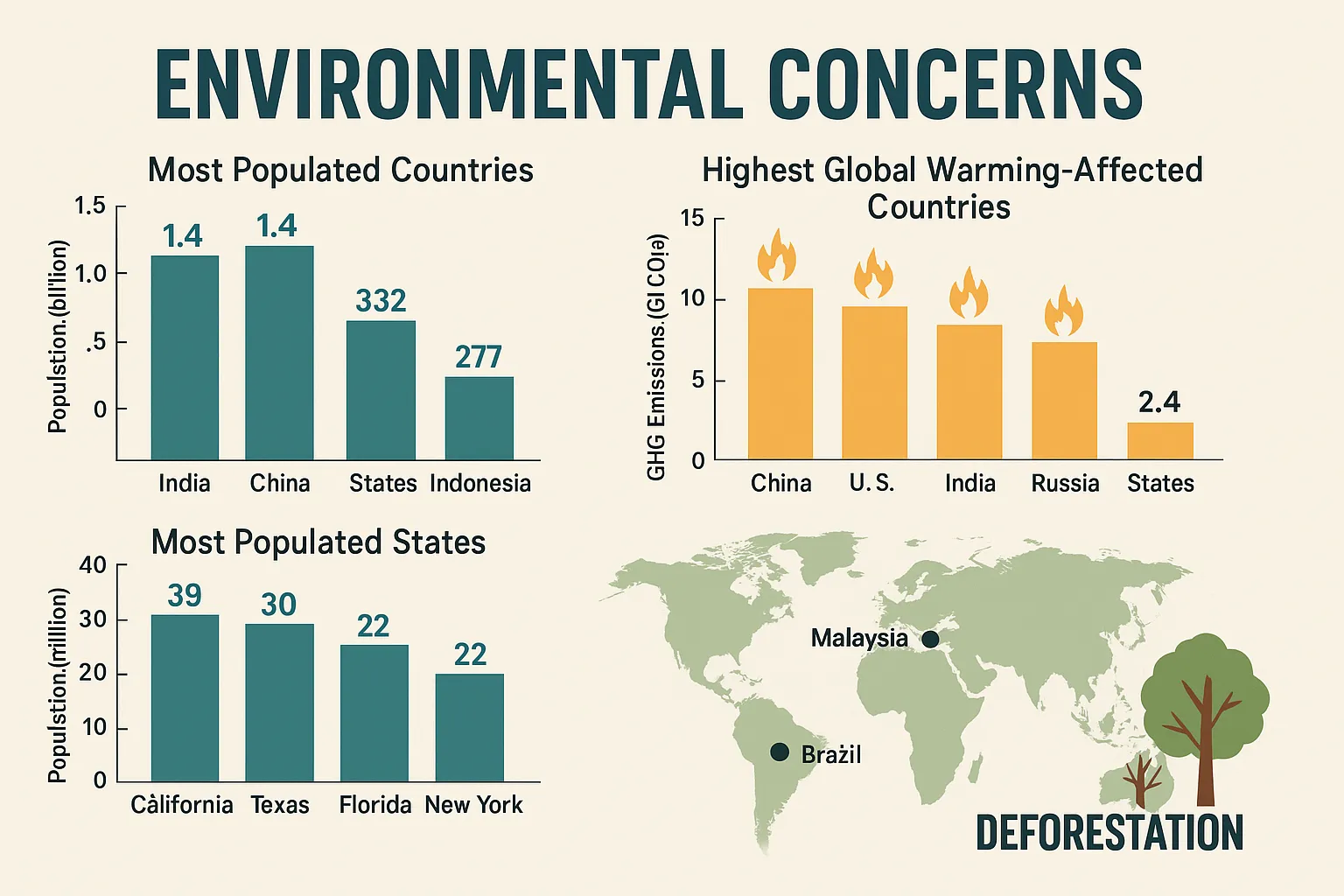Environmental degradation is one of the most pressing challenges of the 21st century. The rapid growth of populations, industrialization, and deforestation have triggered unprecedented changes in the climate. Rising temperatures, shrinking glaciers, worsening air pollution, and increasing carbon emissions are threatening ecosystems, biodiversity, and human life. In this article, we explore the most populated countries, high-emission regions, global warming hotspots, and lesser-known environmental crisis zones, emphasizing the urgent need for climate action.
1. Most Populated Countries & Their Environmental Challenges
Population growth directly impacts environmental degradation. More people equate to higher resource consumption, increased pollution, and greater carbon footprints. The world’s most populous countries are significant contributors to this growing environmental crisis.
Top 5 Most Populated Countries (2024)
The following pie chart illustrates the global distribution of population among the five most populous countries:
Global Population Distribution (Top 5 Countries)
- China and India together make up over 36% of the world’s population, significantly amplifying their environmental impact.
- Other major populations: The United States, Indonesia, and Pakistan also contribute significantly to global environmental challenges.
Key Fact: The combined population of China and India alone contributes to over 36% of the global population, putting immense pressure on their resources and ecosystems.
2. States with the Highest Carbon Footprints
Certain states within heavily populated countries contribute disproportionately to global carbon emissions. Their industrial activities, high energy consumption, and transportation networks make them major players in environmental degradation.
Top 5 High Carbon Emission States (2024 Estimates)
Carbon Emissions by State (Top 5 States)
- States like California, Texas, and Uttar Pradesh in India are among the highest emitters.
- These regions, despite their relatively small landmass, contribute over 30% of the world’s total carbon emissions.
Insight: These top five states are responsible for a large portion of the global carbon footprint, making them key areas for targeted climate action.
3. Global Warming Hotspots & Their Causes
Some regions are warming at an alarming rate, far outpacing the global average. This phenomenon is driven by factors like deforestation, industrial activities, and climate change patterns.
Most Affected Countries by Global Warming
Several countries are feeling the heat more than others. The following analysis shows temperature changes over the past century in countries like Afghanistan, India, and Australia:
Global Warming Hotspots (Temperature Rise 1900–2024)
- Afghanistan, India, and Australia have experienced drastic temperature increases due to urbanization, wildfires, and extensive deforestation.
- The Arctic Region is warming four times faster than the rest of the world, contributing to rapid ice melt and rising sea levels.
Did You Know? The Arctic is warming 4 times faster than the global average, causing alarming rates of ice melt and rising sea levels.
4. Small Yet Crucial Environmental Hotspots
Though smaller in size, certain regions face severe environmental threats that could have disproportionate global consequences.
Notable Environmental Hotspots
- The Maldives: Due to rising sea levels, the Maldives is one of the most vulnerable nations. It is predicted that 80% of the country could be underwater by 2050 if sea levels continue to rise.
- The Amazon Rainforest: As the “lungs of the planet,” the Amazon faces massive deforestation, which threatens biodiversity and accelerates climate change.
- Siberia: Siberia’s permafrost is melting, releasing vast amounts of methane, a potent greenhouse gas, into the atmosphere.
Alarm Bell: The Maldives is at risk of disappearing underwater by 2050. Rising sea levels could submerge up to 80% of the country.
5. The Bigger Picture: A Call for Urgent Action
The relationship between CO₂ emissions and rising temperatures is undeniable. The following graph demonstrates the direct correlation between rising CO₂ levels and the increase in global temperatures from 1900 to 2024:
CO₂ Emissions vs. Temperature Rise (1900–2024)
- As CO₂ emissions have risen over the years, global temperatures have followed suit, leading to devastating climate events.
Key Actions Needed to Address Environmental Degradation:
- Transition to Renewable Energy: Investing in solar, wind, and hydro energy solutions to reduce reliance on fossil fuels.
- Reforestation Initiatives: Large-scale tree planting and forest restoration programs to absorb CO₂ and protect biodiversity.
- Waste Management: Tackling plastic pollution and improving recycling infrastructure globally.
- Water Conservation: Implementing more efficient irrigation systems and investing in desalination technologies.
- Sustainable Urban Planning: Creating green buildings, reducing emissions in cities, and promoting efficient public transportation systems.
Conclusion: The Time to Act is Now
With countries, states, and smaller environmental hotspots all facing significant environmental challenges, immediate action is necessary. Governments, industries, and individuals must collaborate to reduce carbon footprints, conserve resources, and protect our planet.
Final Thought: If global temperatures rise beyond 2°C, irreversible climate disasters will occur. It is crucial that we take action today to prevent further damage









